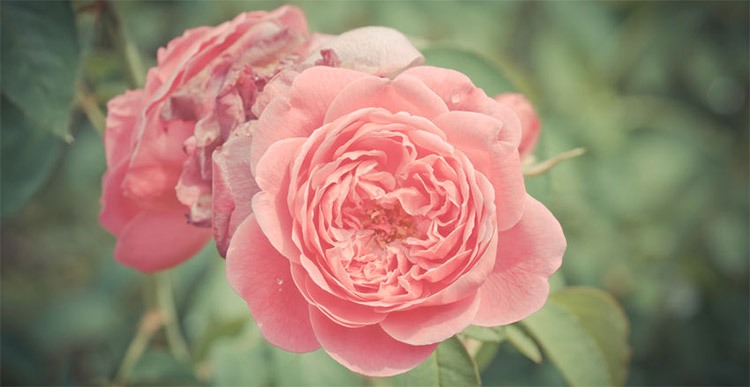Rose Oil: Rose Otto Essential Oil, Rose CO2 Extract and Rose Absolute
Rosa damascena

Description
Steam Distilled Rose Essential Oil is known as Rose Otto. Solvent Extracted Rose Oil is known as Rose Absolute. The CO2 extracted oil is known as Rose CO2 Supercritical Extract and is superior in many ways to Rose Otto Essential Oil and Rose Absolute. They all convey an intoxicating aroma of rose, but there are some differences that are explained further down within this profile.
There are several Rosa species that are used to produce essential oils, absolutes and CO2s, but this profile pertains specifically to the species Rosa damascena. They all share similar applications, but the safety data can change somewhat. Referring to the second edition of Essential Oil Safety by Robert Tisserand is recommended.
For the purposes of this profile, the term Rose Otto Essential Oil will be primarily used. However, many of the details, uses and benefits also apply to Rose Absolute and to Rose CO2 Supercritical Extract.
Rose Otto Essential Oil (and Rose Absolute and Rose CO2 Supercritical Extract) is beneficial to use for emotional, spiritual, perfumery and skin care applications.
However, Rose Otto Essential Oil is also amongst the most precious and expensive of essential oils. Aromatherapy educator Andrea Butje teaches us that it takes all of the petals from 30-50 roses to produce just one single drop of Rose Otto Essential Oil. [Source: Andrea Butje, The Heart of Aromatherapy (Carlsbad, CA: Hay House, Inc., 2017), 6.]
Emotionally, Rose Otto Essential Oil can be helpful during times of intense stress. It is considered by many to be the best oil to use during times of grief. I have personally benefited greatly from using Rose Otto after the death of beloved family members and loved ones. Rose has been helping me get through the grieving process of losing my mom. I wore a blend that included Rose Otto Essential Oil in my aromatherapy necklace on the day of my mother's burial service, and I found it to be very comforting. I chose to not use Rose Otto Essential Oil on its own because I did not want to directly associate or remember Rose with the burial of my mom.
I have read comments from those that have Post Traumatic Shock Disorder (PTSD) that Rose Essential Oil can be helpful for those that suffer from PTSD and varying levels of anxiety. When used in low concentrations, Rose Oil be helpful for insomnia.
Rose Otto Essential Oil is also considered an aphrodisiac.
Therapeutically, Rose Otto Essential Oil is heralded for nurturing maturing skin and for its use with menstruation, menopause and hormonal issues for women.
Rose Otto

Rose Otto Essential Oil is lighter in color and thinner in viscosity than Rose CO2 Supercritical Extract or Rose Absolute. At cooler temperatures, Rose Otto Essential Oil can solidify. This does not hurt the integrity of the oil. AromaWeb's Working with Thicker Oils article provides tips on how to re-liquefy the oil.
Rose Otto Essential Oil or Rose CO2 Extract are the preferred oil for topical aromatherapy applications because Rose Absolute may contain trace amounts of residual solvent. However, Rose Otto Essential Oil is more costly than the absolute because it takes significantly more rose petals to produce Rose Otto than it does to product the absolute.
Aromatically, Rose Otto Essential Oil is a bit lighter and does not possess the hearty, intense aroma that Rose CO2 Extract or Rose Absolute traditionally have. Having said that, Rose Otto is still quite concentrated and a little goes a long way.
Rose CO2 Supercritical Extract
Rose CO2 Supercritical Extract is a bit thicker to work with than either the essential oil or absolute because the CO2 extraction process is able to extract more of the heavier aromatic molecules, natural plant waxes and resins than can the process of steam distillation. Aromatically, Rose CO2 Supercritical Extract offers a beautiful, floral aroma that is more complete and more closely represents the natural fragrance of fresh roses (Rosa damascena). For more information on CO2 Supercritical Extracts, see AromaWeb's CO2 Supercritical Extract article.
Rose Absolute

Rose Absolute is often favored by fragrance formulators and perfumists for its fragrance, aromatic strength and lower cost than Rose Otto Essential Oil or Rose CO2 Supercritical Extract.
Rose Essential Oil, Rose Absolute and Rose CO2 Extract Benefits and Uses
- Depression
- Grief
- Eczema
- Frigidity
- Mature Skin
- Menopause
- Stress
Source: Julia Lawless, The Encyclopedia of Essential Oils (Updated Edition) (London: Harper Thorsons, 2014), 172-173.
Botanical Name
Rosa centifolia is another variety of rose that is sometimes used to produce Rose Essential Oil or Rose Absolute. Aromatics produced from Rosa centifolia are sometimes known as Rose Maroc.
Plant Family
Common Methods of Extraction
Steam Distilled (called Rose Otto Essential Oil), Solvent Extracted (called Rose Absolute) or CO2 Extracted (called Rose CO2 Extract)
- What is a Steam Distilled Essential Oil (Otto)?
- What is a CO2 Extract?
- What is a Solvent Extracted Absolute?
Plant Part Typically Used
Color
Rose Absolute is deep red in color. Rose Otto Essential Oil tends to be light yellow in color.
Consistency
Rose Absolute has a thick consistency. Rose Otto Essential Oil has a thin consistency.
Perfumery Note
Middle
Strength of Initial Aroma
Strong
Aromatic Description
Rose Otto Essential Oil and Rose Absolute smell floral and sweet with an intense, concentrated rose aroma.
Major Constituents of Bulgarian Rose Otto
- Citronellol
- Geranoil
- Alkenes & Alkanese
- Nerol
- Methyleugenol
- Linalool
- Citronellyl Acetate
- Ethanol
- 2-Phenylethanol
See Essential Oil Safety for more complete list of typical constituents.
Source: E. Kovats. Composition of Essential Oils Part 7. Bulgarian Oil of Rose (Rosa damascena Mill). (J. Chromatog. 406, 1987), 185-222. A.O. Tucker, M.J. Maciarello. Nomenclature and Chemistry of the Kazanlik Damask Rose. (In: B.M. Lawrence, B.D. Mookherjee, B.J. Willis (Eds.), Flavors & Fragrances: a World Perspective. Amsterdam: Elsevier, 1988), 99-114. M.H. Boelens, H. Boelens. Differences in Chemical and Sensory Properties of Orange Flower and Rose Oils Obtained from Hydrodistillation and from Supercritical CO2 Extraction. (Perfumer & Flavorist 22, 1997), 31-35. L. Jirovetz, G. Buchbauer, M. Shahabi. Comparative Investigations of Essential Oils and Their SPME Headspace Volatiles of Rosa damascena from Bulgarian and Rosa centifolia from Morocco Using GC-FID, GC/MS and Olfactometry. (Journal of Essential Oil Bearing Plants 5, 2002), 111-121. Sources cited in Robert Tisserand and Rodney Young, Essential Oil Safety (Second Edition. United Kingdom: Churchill Livingstone Elsevier, 2014), 405.
Rose Essential Oil Safety Information
Essential Oil Safety forewarns that Rose Otto may contain methyeugenol and states: "We recommend a dermal maximum of 0.6% and a maximum oral dose of 21mg, based on 3.3% methyleugenol content, with dermal and oral limits of 0.02% and 0.01mg/kg for methyleugenol). Guidelines for maximum dermal usage:
EU: 0.006%
IFRA: 0.012%
Tisserand & Young: 0.6%
For more complete information, refer directly to Essential Oil Safety.
[Robert Tisserand and Rodney Young, Essential Oil Safety (Second Edition. United Kingdom: Churchill Livingstone Elsevier, 2014), 405.]
Rose CO2 Supercritical Select Extract
In addition to being available as an essential oil, this botanical is available from a small number of reputable sources as a CO2 extract. CO2 extracts offer many advantages. However, they can have differing safety precautions than essential oils because the natural chemistry of CO2 extracts can differ from their essential oil counterparts. Not much safety information is documented from trusted sources for CO2 extracts. Use CO2 extracts with great care and do not assume that every CO2 extract has the same safety precautions as its essential oil counterpart.
General Safety Information
Do not take any oils internally and do not apply undiluted essential oils, absolutes, CO2s or other concentrated essences onto the skin without advanced essential oil knowledge or consultation from a qualified aromatherapy practitioner. For general dilution information, read AromaWeb's Guide to Diluting Essential Oils. If you are pregnant, epileptic, have liver damage, have cancer, or have any other medical problem, use oils only under the proper guidance of a qualified aromatherapy practitioner. Use extreme caution when using oils with children and be sure to first read the recommended dilution ratios for children. Consult a qualified aromatherapy practitioner before using oils with children, the elderly, if you have medical issues or are taking medications. Before using this or any essential oil, carefully read AromaWeb's Essential Oil Safety Information page. For in-depth information on oil safety issues, read Essential Oil Safety by Robert Tisserand and Rodney Young.
Shelf Life
Important Information About the Profiles
The essential oil information provided on AromaWeb is intended for basic educational purposes only. The references to safety information, test results, constituents and percentages is generalized information. Essential oils can vary greatly in composition. The data is not necessary complete and is not guaranteed to be accurate. The essential oil photos are intended to represent the typical and approximate color of each essential oil. However, essential oil composition and color can vary based on harvesting, distillation, age of the essential oil and other factors. Profiles for several CO2 Extracts and absolutes are included within the directory, and are denoted as such.
